初中英语阅读复习课教学设计.docx
- 格式:docx
- 大小:38.99 KB
- 文档页数:11
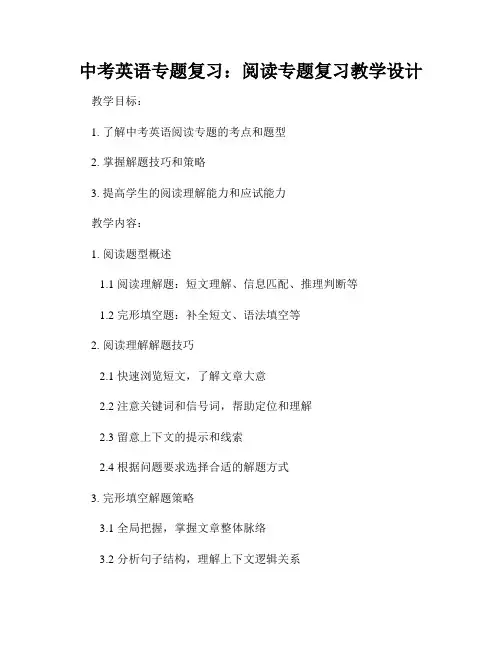
中考英语专题复习:阅读专题复习教学设计教学目标:1. 了解中考英语阅读专题的考点和题型2. 掌握解题技巧和策略3. 提高学生的阅读理解能力和应试能力教学内容:1. 阅读题型概述1.1 阅读理解题:短文理解、信息匹配、推理判断等1.2 完形填空题:补全短文、语法填空等2. 阅读理解解题技巧2.1 快速浏览短文,了解文章大意2.2 注意关键词和信号词,帮助定位和理解2.3 留意上下文的提示和线索2.4 根据问题要求选择合适的解题方式3. 完形填空解题策略3.1 全局把握,掌握文章整体脉络3.2 分析句子结构,理解上下文逻辑关系3.3 根据语境和语法规则,选择合适的词语填空教学步骤:一、导入新知为了激发学生的学习兴趣和主动性,可以通过设置开放式问题或给出一段引人入胜的短文引导学生进入主题,如一篇关于环保的报道。
二、介绍考点和题型通过展示中考英语阅读题的样例和解析,让学生了解到中考英语阅读题的特点和难点,引导学生对考点有初步认识。
三、进行阅读题解析1. 阅读理解题解析根据选取的一篇适合中考题型的短文,以课堂讨论的方式进行解析,引导学生掌握解题技巧和策略。
2. 完形填空题解析选取一篇适合中考题型的完形填空短文,通过详细解析其中的关键句和重要词汇,让学生理解解题技巧和策略。
四、巩固练习根据学生的阅读理解能力和考试准备程度,设计一些有针对性的练习题,通过个人、小组或全班形式进行练习,鼓励学生运用所学知识解题。
五、拓展延伸提供一些额外的阅读材料,让学生自主阅读,并设计一些开放性的问题,引导学生进一步思考和拓展知识。
六、总结反思与学生一起总结本堂课的学习成果和收获,让学生分享解题经验和策略,鼓励学生交流和互助。
七、布置作业根据学生的学习情况,布置一些适当的作业,巩固所学知识和技巧。
作业可以包括练习题、阅读材料或写作练习。
八、教学反思回顾整堂课的教学过程,分析学生的学习情况和表现,及时调整教学策略和方法,为后续教学做好准备。
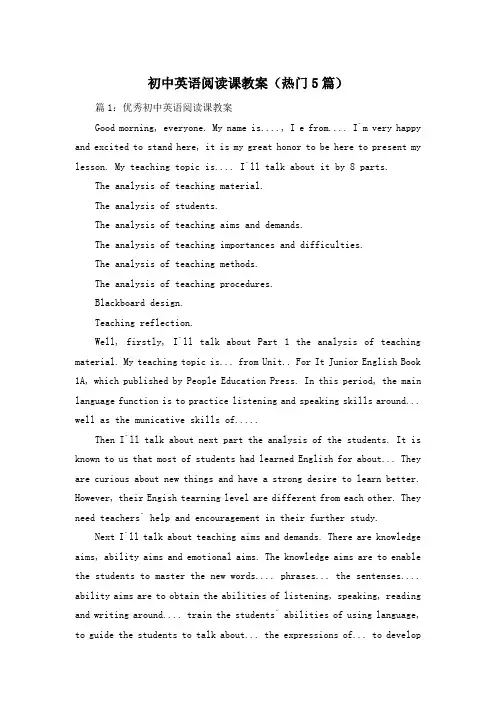
初中英语阅读课教案(热门5篇)篇1:优秀初中英语阅读课教案Good morning, everyone. My name is...., I e from.... I`m very happy and excited to stand here, it is my great honor to be here to present my lesson. My teaching topic is.... I`ll talk about it by 8 parts.The analysis of teaching material.The analysis of students.The analysis of teaching aims and demands.The analysis of teaching importances and difficulties.The analysis of teaching methods.The analysis of teaching procedures.Blackboard design.Teaching reflection.Well, firstly, I`ll talk about Part 1 the analysis of teaching material. My teaching topic is... from Unit.. For It Junior English Book 1A, which published by People Education Press. In this period, the main language function is to practice listening and speaking skills around... well as the municative skills of.....Then I`ll talk about next part the analysis of the students. It is known to us that most of students had learned English for about... They are curious about new things and have a strong desire to learn better. However, their Engish tearning level are different from each other. They need teachers` help and encouragement in their further study.Next I`ll talk about teaching aims and demands. There are knowledge aims, ability aims and emotional aims. The knowledge aims are to enable the students to master the new words.... phrases... the sentenses.... ability aims are to obtain the abilities of listening, speaking, reading and writing around.... train the students` abilities of using language, to guide the students to talk about... the expressions of... to developthe students` ability of creative thinking and cooperative study. The emotional aims are to enable.....Let`s move on to another part: the analysis of teaching importances and difficulties. The teaching importances are... teaching difficulties are.....Next is teaching methods. I use.. in my lesson. There are multimedia puter assisted instruction, task-based activities, situational approach, total physical response or the audio-lingual method.Now I`ll talk about teaching procedures. According to five steps teaching method, I design my lesson into five steps.Step 1 is warm-up. Here I`ll... this, the students can be interested in it and pay their attention to our class easily and....Step 2 is lead-in. Here I`ll... this, the students.....Step 3 is presentation. Here I`ll.... this, the students...... Step 4 is practice. Here I`ll... this, the students......Step 5 is homework. Here I`ll..... this ,the students.....Next is my blackboard design. I`ll design it like this.....At last, I want to say, to be a good teacher is my dream. I think a teacher is not only a guide for sudents, but also a friend of them. If I were a teacher, I would build a close relation with my students, helping them not only on their study but also on their lives. I`ll try my best, and I have confident that I can do it.Ok, that`s all. Thanks for your listening. Good-bye.篇2:优秀初中英语阅读课教案Unit 10 Where did you go on vacation?Good morning, everyone. I am from the . I have taught English for over ten years and I like my students. Today, I will talk about Unit 10 where did you go on vacation? Go for it Junior English Book are 6 periodsto finish this unit. I will talk about the first period with the following parts..I. Analysis of the Teaching Materials.The topic of this unit is the continuation of unit 9 as well as about the past events.By using the Simple PasT Tense,which is essential in junior English,students willtalk about their topic is about their experiences and places they havevisited on their it helps bring back their memories and learning motivations.II. Students’ characteristicAlthough the Junior 1 has been learning English for almost a year and are havingsome basic knowledge. Because of living in China and surrounding environment, students are learning English impassively and irregularly. But The junior 1 has showned themselves very creative,capable and of plasticity as they’re doing so well in what they’re interested in such as games and CAI.Aims and Demandsobjectivesa. To enable the students to read, to spell , to understand the vocabulary correctly.b. To help the students ask and answer the new sentence pattern: Where did you go on vacation?objectives.a. To improve the students’ skills of listening ,speaking,reading and writing..b. To encourage the students to municate with others uning the newsentence pattern .objectivesa. To train the Ss to cooperate well in groups and in pairs.b. To be interested in municating in English.IV. Teaching Key Points1. Key vocabularyNew York City camp summer camp museum2. Key structuresWhere did you go on vacation?I went to…V. Teaching DifficultyLearn the key structuresVI. Teaching Methods1. Task-based methodThat’s to say I’ll let the students finish 1 listening task and make short dialogues along with the actions to help the students get a better understanding of the keystructures.2. munication methodI’ll set up a dream and ask students to pretent themse lves as reporters. This way, the students can say freely and needn’t to worry about making mistakes.VII. Learning Methods1. Listening—speaking method2. municative strategyWe all know that the best ways to learn English well are to imitate,to practice,to listen,to speak and to municate more constantly.VIII. Teaching AidsIn this lesson, the CAI, cassette, a tape recorder will be used.X. Teaching ProcedureI’ll mainly talk about this part. It consists of 5 steps.Step 1 Warm – up and review1. Make a free talk between T-S. What did you do yesterday? And what did your best friend do yesterday?2. Write down the past tenses of the verbs that I show in CAI.Purpose: this step is in order to review what the students have learnt in Unit way, I can lead them into the new lesson smoothly. I think It’s usual but pratical.Step 2 Presentation1. Learn the new words and expressionsa. lead—in: ask students some questions: Did you dream last night? What did you dream? Where did I go on vacation in my dream?b. CAI shows many pictures of my dream,which are also the activities in 1a .c. Ask students to read and spell the new phrases.d. Do 1a. Match the activities with the pictures (a—g).e. Play a guessing game: I will show some jigsaws of each picture and have the students to guess. I will praise the student who answers more quickly.Purpose: I put the vocabulary learning into a dream in order to prompt them to find it very interesting to learn English.. By CAI, students can match the vocabulary with the real things directly and master them easily. Step 3 Listening practicea. Tell the students to listen to the tape and number the people (1—5) in the picture.b. Play the recorder for the first time, and then check the answers.c. Play the recorder again, students imitate the conversations and fill in the blanks. Pay attention to their pronunciation and intonation.Purpose: this is a basic and necessary step, which develops the students’ skills of listening, reading and writing.Step 4 Pairworka. T—S: where did Tina go on vacation?She went to the mountains.b. Ask the students to practice in pairs as we 1c. Then they will e to the platform and click on the number to choose a picture and act it out randomlyPurpose: “Task-based”teaching method is used here to develop the students’ability ofmunication and their ability of co-operation will be well trained. This step provides guided oral practice using the target language to consolidate the key structure and It can develop students’ skill of speaking and sense of language.Step5 ProductionHave students pretent to be reporters to interview anyone they want to ask about their vacation.Purpose: After learning 1a—1c, it’s time to extend what they learnt just now and give the students a free space to show their abilities. With the real situations, students will feel easy and successful during this part. By way of munication, the students will understand how to use the key structure better and consolidate the knowledge firmly.Part XI HomeworkDo a survey and write a report about the classmates’ vocation. Purpose: I think homework is so important that the students can speak english as much as they can in class or after set this step in order to practice students’ skills of listening, speaking and writing.Blackboard Design篇3:优秀初中英语阅读课教案教学目标教学目标Aim 记忆物品pants , socks , T-shirt , shirt , shorts , sweater , shoes理解颜色理解:color , black , white , red , green , blue ,应用通过布置任务,让学生在合作中进行语言交流。

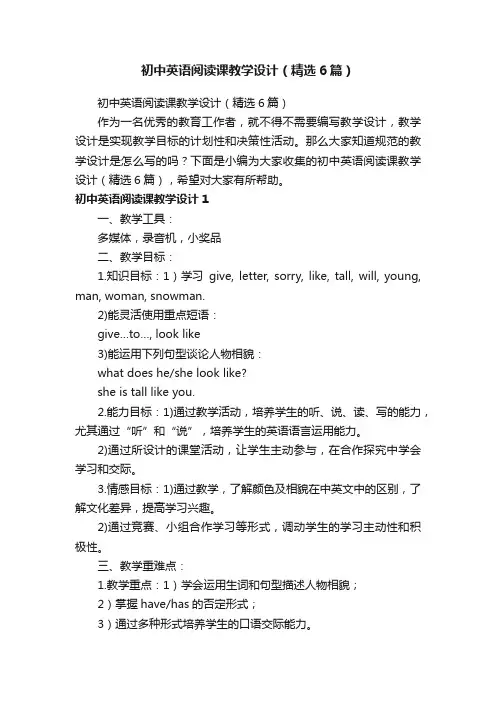
初中英语阅读课教学设计(精选6篇)初中英语阅读课教学设计(精选6篇)作为一名优秀的教育工作者,就不得不需要编写教学设计,教学设计是实现教学目标的计划性和决策性活动。
那么大家知道规范的教学设计是怎么写的吗?下面是小编为大家收集的初中英语阅读课教学设计(精选6篇),希望对大家有所帮助。
初中英语阅读课教学设计1一、教学工具:多媒体,录音机,小奖品二、教学目标:1.知识目标:1)学习give, letter, sorry, like, tall, will, young, man, woman, snowman.2)能灵活使用重点短语:give…to…, look like3)能运用下列句型谈论人物相貌:what does he/she look like?she is tall like you.2.能力目标:1)通过教学活动,培养学生的听、说、读、写的能力,尤其通过“听”和“说”,培养学生的英语语言运用能力。
2)通过所设计的课堂活动,让学生主动参与,在合作探究中学会学习和交际。
3.情感目标:1)通过教学,了解颜色及相貌在中英文中的区别,了解文化差异,提高学习兴趣。
2)通过竞赛、小组合作学习等形式,调动学生的学习主动性和积极性。
三、教学重难点:1.教学重点:1)学会运用生词和句型描述人物相貌;2)掌握have/has的否定形式;3)通过多种形式培养学生的口语交际能力。
2.教学难点:1)have/has的否定形式的教学;2)上课如何调动学生积极性。
四、教学过程step 1 warm up:enjoy a songreview the words about colors.t: we enjoyed a song just now. we have learned some words about color in section a. now please answer my questions.1) what color is it?2) how do you spell it?step 2 presentation1.lead in 3.talk about the colors of some national flags. finish 3.t: what color is the national flag?where is he/she from?what color is his/her hair?what color are his/her eyes?t: do pair works. then ask some pairs to act it out.2. lead in 2.teach “what does he/she look like?”(show another two pictures of women)(teach new words and phrases: look like, tall, man, woman, young.)t: what does the woman look like?ss: she is young. she has short blond hair and a small nose.t: what does the man look like?ss: he is old. he doesn?t have gray hair. his hair is black.(show the four pictures in part 2.)t: turn to page 35, look part 2. match the descriptions with the pictures.(ss match them)t: let?s check the answers.t: do pair works, ask and answer according to the four pictures.3. pair work: talk about the pictures, finish 2.step 3 look, listen and say1.(拿出事先准备好的一个学生的书。
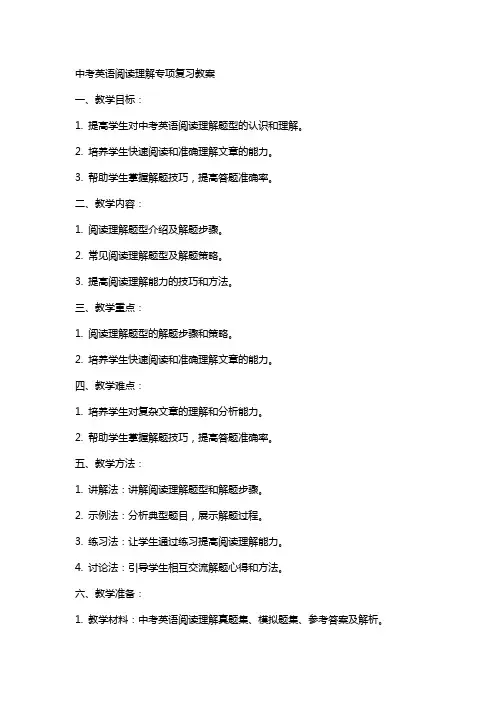
中考英语阅读理解专项复习教案一、教学目标:1. 提高学生对中考英语阅读理解题型的认识和理解。
2. 培养学生快速阅读和准确理解文章的能力。
3. 帮助学生掌握解题技巧,提高答题准确率。
二、教学内容:1. 阅读理解题型介绍及解题步骤。
2. 常见阅读理解题型及解题策略。
3. 提高阅读理解能力的技巧和方法。
三、教学重点:1. 阅读理解题型的解题步骤和策略。
2. 培养学生快速阅读和准确理解文章的能力。
四、教学难点:1. 培养学生对复杂文章的理解和分析能力。
2. 帮助学生掌握解题技巧,提高答题准确率。
五、教学方法:1. 讲解法:讲解阅读理解题型和解题步骤。
2. 示例法:分析典型题目,展示解题过程。
3. 练习法:让学生通过练习提高阅读理解能力。
4. 讨论法:引导学生相互交流解题心得和方法。
六、教学准备:1. 教学材料:中考英语阅读理解真题集、模拟题集、参考答案及解析。
2. 教学工具:投影仪、电脑、黑板、粉笔。
七、教学过程:1. 课堂导入:简要介绍中考英语阅读理解题型及重要性。
2. 新课内容:讲解阅读理解题型和解题步骤,分析典型题目。
3. 课堂练习:让学生进行阅读理解练习,教师即时批改并给予反馈。
4. 总结讲解:针对学生练习中出现的问题,讲解解题技巧和方法。
八、课后作业:1. 让学生完成一定数量的阅读理解练习题。
2. 要求学生总结解题心得和方法,并在下一节课分享。
九、教学评价:1. 课堂表现:观察学生在课堂上的参与度和积极性。
2. 练习成果:评估学生在课后作业中的表现,对答题准确率进行统计。
3. 学生反馈:收集学生对教学内容的意见和建议,以便进行调整和改进。
十、教学反思:1. 总结课堂教学的优点和不足。
2. 根据学生反馈和教学评价,调整教学方法和内容。
3. 制定后续教学计划,确保学生在中考英语阅读理解方面取得优异成绩。
重点和难点解析一、教学目标:在制定教学目标时,应关注如何使学生明确中考英语阅读理解的重要性,并设定具体可衡量的发展目标,如提高学生的阅读速度、理解深度和答题技巧。
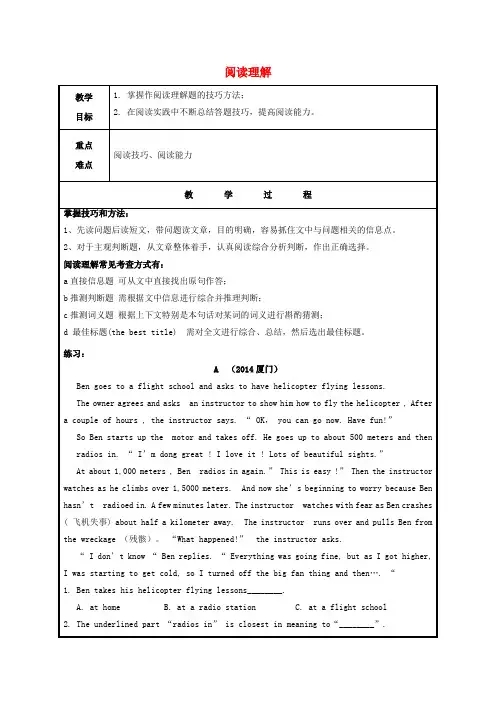
阅读理解A.communicates with someone by radio B.puts the radio inside C. turns on the radio3. At a height of about _______ meters, the instructor is starting to worry about Ben.A. 500B. 1,000C. 1,5004. According to the passage, we know that Ben _______.A. was killed in the crash about half a kilometer awayB. was doing fine with the flying at different heightsC. was feeling cold on the helicopter before the crash5. The possible reason for the crash is that Ben _______.A. shut off the big fan thing on the helicopterB. refused to talk with the instructorC. kept radioing in on the helicopterB(2014呼和浩特)Our village carpenter (木匠) , John, came one day and made a dining table for my wife.He made it just the right size for the space between the two windows.When I got home that evening, John was drinking a cup of tea and writing out his bill for the job.My wife said to me quietly,“That’s his ninth cup of tea today.”But she said, in a loud voice,“It’s a beautiful table, dear, isn’t it?”“I’ll decide about that when I see the bill.”I said.John laughed and gave me his bill for the work.I read:One dining table 10 November, 1998Cost of wood $17.00Paint $1.50Work, 8 hours ( $1 an hour ) $8.00Total $36.50When I was looking at the bill, John said, “It’s been a nice day, hasn’t it?Quite sunny.”“Yes.”I said.“I’m glad it’s only the tenth of November.”“Me, too.”said John.“You wait —it’ll be a lot colder by the end of the month.”“Yes,colder — and more expensive! A dining table will be $20 more expensive on November 30, won’t it, John?”John looked hard at me for half a minute.Was there a little smile in his two blue eyes?I gave his bill back to him.“If there isn’t too much trouble, John,” I said,“please add it up again.You can forget the date…”I paid him $26.50 and he was happy to get it.1.Why did John talk about the weather when the writer was looking at the bill?A.Because he didn’t want the writer to go through the bill carefully.B.Because it was really a fine day.C.Because he wanted the writer to check the bill carefully.D.Because he wanted to tell the writer what the weather was like.2. The writer thought John would ask for _______ if he made a dining table on the last day of November.A.$20.00 B.$46.50 C.$56.5 D.$26.503.When the writer gave John the money, he was happy because _______.A.he got what he should get for his workB.he got much more money for his workC.he got the money easilyD.he didn’t have to add up the cos ts again4.From the story we know that ______.A.John made a mistake in the billB.John tried to fool the writer in order to get more money for his workC.John had written out the bill before the writer got homeD.John still wanted to get $36.50 for his work in the end5.What do you think of the writer? He is ______.A.honest B.clever C.foolish D.afraidC(2014 南京)More than anything else in the world, Lion liked being King of the jungle. He walked around, showing off his power and pride.Each day Lion took a long lazy sleep under the shade of his favourite tree. Healways dreamed of weaker animals bowing(鞠躬) before him.One day Mouse ran through the jungle and tripped over Lion’s huge paws. Lion woke up with a start. “How dare you wake me up! ” he shouted angrily. Lion grabbed Mouse with one paw. “On the second thought, I’m in the mood for the snack, and you’ll make a delicious meal.”, he said.Mouse cried out, “King Lion, please spare(饶恕)me! If you let me live, I’ll always remember your kind ness. And, some day, I might be able to help you.”“ How could such a powerless little mouse ever help me?” That thought made Lion laugh so much that he decided to let Mouse go. A week later, Lion was walking through the jungle on the way to his favourit e tree when he stepped onto a hunter’s net. The net scooped him up. No matter how he twisted and turned, he couldn’t escape.When Mouse heard Lion’s frightened shouts, he raced to help. Mouse quickly chewed (咬)through the ropes to make a hole in the net. Soon, Lion moved out and was free. Lion looked down at the little mouse. “Thank you for saving my life,” said Lion, smiling his widest smile. “I was mistaken. You are not a powerless little mouse. You area great friend!”1. What did Lion do each day?A. He stepped onto a hunter’s net.B. He bowed before weaker animals.C. He showed kindness to animals in the jungle.D. He had a good sleep under his favourite tree.2. How did Mouse wake up Lion?A. He made a hole in the net.B. He shouted at Lion angrily.C. He tripped over Lion’s paws.D. He prepared a delicious meal for Lion.3. Why did Lion let Mouse go?A. Because he was trapped in the net.B. Because he took Mouse as his good friend.C. Because he believed Mouse could save him.D. Because he doubted if Mouse could be of any help.4. What do you think of Mouse?A. Clever and honest.B. Silly and lazyC. Humorous and stubbornD. Proud and selfish.5. What can we learn from the passage?A. Pride makes you lose what you have.B. Don’t put all your eggs in one basket.C. Even the small can show great strength.D. When the cat’s away, the mice will play.1. 整理笔记2.完成《考易通》教学反思:。

2019重庆市初三英语复习研讨会教学设计I.教学主题:基于核心素养下的学生思维能力培养(初三阅读复习课)II. 设计背景1. 基于中考考纲:阅读理解比重将继续增加。
直接考查语言知识的试题有所减少,对学生思维能力考查的比重相应增加。
阅读理解中对高阶思维能力的考察的题型也在不断增加,创新性题型近来每年都有出现。
2. 基于英语课程标准(2011年版):五级阅读能力标准明确了以下几种能力:1.能根据上下文和构词法推断,理解生词的含义。
2.能理解段落中各句子之间的逻辑关系。
3.能找出文章中的主题,理解故事的情节,预测故事情节的发展和可能的结局。
4.能读懂常见体裁的阅读材料。
5.能根据不同的阅读目的运用简单的阅读策略获取信息。
3. 基于核心素养的思维品质:培养学生的思维品质,旨在培养学生在逻辑性,批判性,创造性等方面的思维能力。
2. 基于学情分析:语篇理解是难点,对于运用高阶思维能力如归纳,推断,预测,逻辑分析等的题目是丢分的重头。
学生缺乏对于阅读题型的归纳和梳理,特别是对基于高阶思维能力的解题策略掌握不够。
III.设计思路1.通过课前自主学习-分享反馈-难点突破-拓展运用-创新升华等环节,有的放矢的训练学生的思维能力,从而提高阅读理解的解题技巧。
2.复习重难点:1)重点:归纳出阅读理解中的各种题型以及培养学生与之对应的阅读能力。
2)难点:学生梳理出高阶思维的解题策略,并利用策略解答创新题型。
3. Objectives复习目标1)通过自主学习的课前预测,学生总结出常规阅读题型的解题思路。
2)通过分享反馈,学生能进一步了解题目背后考察的思维能力和课程标准中要求达到的阅读能力。
3)通过难点突破,学生在小组合作与老师的帮助下,归纳出高阶思维题型的解题策略。
4)通过拓展运用,学生能够利用解题策略,在语篇理解中提高答题技巧。
5)通过整个活动,学生体会到思维的美感,培养学生理性思考的习惯。
IV.教学过程Part One: 自主学习Steps Evaluation学习评价或反馈资源、形式等Objectives达成目标1. 课前阅读测试:在30分钟左右完成一套阅读题。
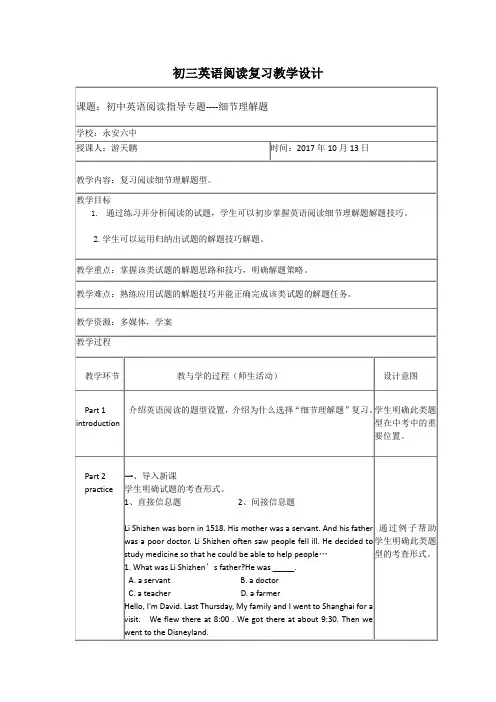
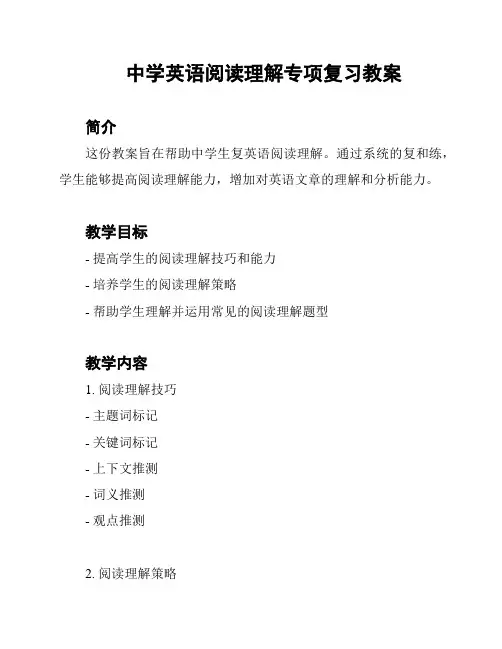
中学英语阅读理解专项复习教案简介这份教案旨在帮助中学生复英语阅读理解。
通过系统的复和练,学生能够提高阅读理解能力,增加对英语文章的理解和分析能力。
教学目标- 提高学生的阅读理解技巧和能力- 培养学生的阅读理解策略- 帮助学生理解并运用常见的阅读理解题型教学内容1. 阅读理解技巧- 主题词标记- 关键词标记- 上下文推测- 词义推测- 观点推测2. 阅读理解策略- 快速浏览文章,了解大意- 高效阅读,找出关键信息- 理解作者观点,分析文章结构- 掌握问题解答技巧,尤其是排除法3. 阅读理解题型- 判断正误题- 选择题- 完形填空- 阅读推断题教学方法1. 整体导入法:通过引入感兴趣的话题或故事,激发学生的阅读兴趣和动力。
2. 分析法:针对不同的题型,进行分析和讲解相关的解题技巧,帮助学生理解题意。
3. 练与训练:提供大量的阅读理解练题,让学生通过实际操作巩固所学知识和技巧。
4. 反馈与讨论:对学生的答案进行及时反馈和讨论,帮助学生发现和纠正错误,提高对题目的理解和思考能力。
教学评估1. 阅读理解作业:布置一定数量的阅读理解题目,学生独立完成并提交答案。
2. 小组讨论:组织学生进行小组讨论,分享解题思路和答案,并互相评价和给予建议。
3. 个别辅导:针对提供错题辅导,对学生进行个别指导和补充练,帮助他们进一步提高。
计划安排- 第一周:阅读理解技巧讲解和练- 第二周:阅读理解策略讲解和练- 第三周:阅读理解题型讲解和练- 第四周:教学评估和复总结教学资源- 中学英语教材或相关教辅- 阅读理解练题集- 网络资源和多媒体设备结束语通过本教案的实施,相信学生们会在英语阅读理解方面取得显著进步。
请学生们积极参与,勤加练习,相信你们一定能够取得优异的成绩!。
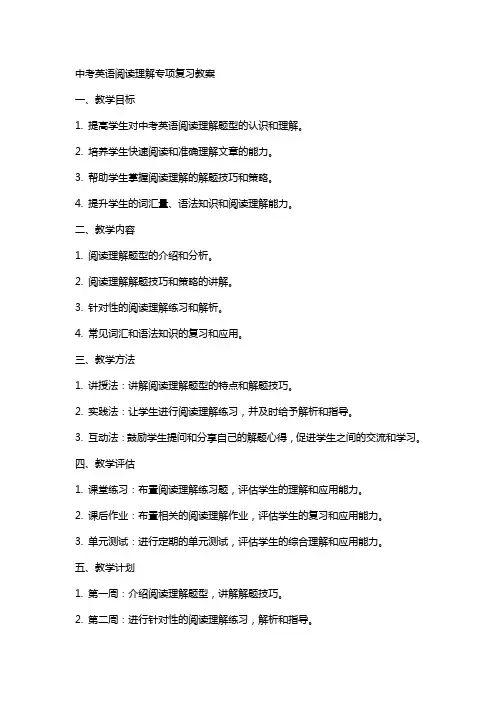
中考英语阅读理解专项复习教案一、教学目标1. 提高学生对中考英语阅读理解题型的认识和理解。
2. 培养学生快速阅读和准确理解文章的能力。
3. 帮助学生掌握阅读理解的解题技巧和策略。
4. 提升学生的词汇量、语法知识和阅读理解能力。
二、教学内容1. 阅读理解题型的介绍和分析。
2. 阅读理解解题技巧和策略的讲解。
3. 针对性的阅读理解练习和解析。
4. 常见词汇和语法知识的复习和应用。
三、教学方法1. 讲授法:讲解阅读理解题型的特点和解题技巧。
2. 实践法:让学生进行阅读理解练习,并及时给予解析和指导。
3. 互动法:鼓励学生提问和分享自己的解题心得,促进学生之间的交流和学习。
四、教学评估1. 课堂练习:布置阅读理解练习题,评估学生的理解和应用能力。
2. 课后作业:布置相关的阅读理解作业,评估学生的复习和应用能力。
3. 单元测试:进行定期的单元测试,评估学生的综合理解和应用能力。
五、教学计划1. 第一周:介绍阅读理解题型,讲解解题技巧。
2. 第二周:进行针对性的阅读理解练习,解析和指导。
3. 第三周:复习相关词汇和语法知识,进行应用练习。
4. 第四周:进行单元测试,评估学生的理解和应用能力。
5. 第五周:针对学生的弱点进行复习和强化训练。
六、教学资源1. 教材:中考英语阅读理解专项复习教材。
2. 辅助材料:相关阅读理解练习题和答案解析。
3. 多媒体设备:电脑、投影仪等,用于展示教材和辅助教学。
4. 网络资源:查找相关的阅读理解练习题和答案解析,以便进行拓展训练。
七、教学进程1. 课前准备:教师提前准备好教材、辅助材料和教学设备。
2. 课堂讲解:教师根据教案进行讲解,引导学生理解和掌握阅读理解的解题技巧。
3. 课堂练习:教师布置针对性的阅读理解练习题,学生进行练习,教师及时给予解析和指导。
4. 课后作业:教师布置相关的阅读理解作业,学生进行复习和巩固。
5. 单元测试:教师进行定期的单元测试,评估学生的综合理解和应用能力。
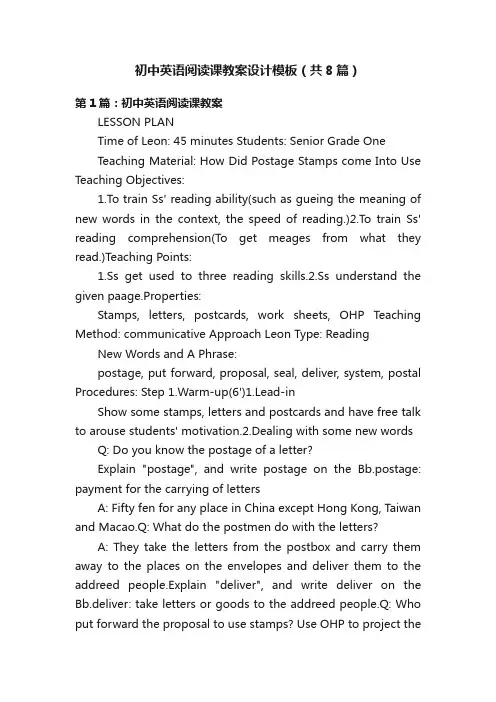
初中英语阅读课教案设计模板(共8篇)第1篇:初中英语阅读课教案LESSON PLANTime of Leon: 45 minutes Students: Senior Grade OneTeaching Material: How Did Postage Stamps come Into Use Teaching Objectives:1.To train Ss' reading ability(such as gueing the meaning of new words in the context, the speed of reading.)2.T o train Ss' reading comprehension(To get meages from what they read.)Teaching Points:1.Ss get used to three reading skills.2.Ss understand the given paage.Properties:Stamps, letters, postcards, work sheets, OHP Teaching Method: communicative Approach Leon Type: Reading New Words and A Phrase:postage, put forward, proposal, seal, deliver, system, postal Procedures: Step 1.Warm-up(6')1.Lead-inShow some stamps, letters and postcards and have free talk to arouse students' motivation.2.Dealing with some new words Q: Do you know the postage of a letter?Explain "postage", and write postage on the Bb.postage: payment for the carrying of lettersA: Fifty fen for any place in China except Hong Kong, Taiwan and Macao.Q: What do the postmen do with the letters?A: They take the letters from the postbox and carry them away to the places on the envelopes and deliver them to the addreed people.Explain "deliver", and write deliver on the Bb.deliver: take letters or goods to the addreed people.Q: Who put forward the proposal to use stamps? Use OHP to project thequestion onto the screen.Explain "put forward" and "proposal", and write them on the Bb.put forward: put an idea before people for thinking over proposal: sth.proposed, plan or idea, suggestion Again: Who put forward the proposal to use stamps? Step 2.Skimming(4'30")1.InstructionsT: Now I give you a paage to read, and for the first time you should only find the answer to the question.You have only two and a half minutes to read.So don't read word for word.Read quickly.Just try to find the answer.2.Handing out the reading material and reading 3.CheckingQ: Who put forward the proposal to use stamps.A: Rowland Hill, a schoolmaster in England.Step 3.Scanning(6')1.Instructions T: This time I give you three minutes to read the paage.When you are reading, find the answers to the two e OHP to project the questions:1.Why was the postage high in the early nineteenth century when people did not use stamps?2.When was postage stamps first put to use? 2.Reading3.Checking 1)Pair work 2)Cla checkingAns.to Que.1.Because the post offices had to send many people to collect the postage.Ans.to Que.2.On May 6, 1840.Step 4.Full reading(21')1.InstructionsT: Now I give you ten minutes to read the paage for the third time and you should read it carefully.Before reading, let's go over the questions on the work sheet.Give Work Sheet 1 to the Ss.Explain the new words in Que.4.prevent: stop, not let sb.do sth.reuse: use againT: Try to find the answers to the questions.But don't write the answers down, you can put a sign or underline the sentences concerning the questions.2.Reading 3.Checking1)Group work: Checking the answers in a group of four Ss.2)Cla work: Checking the answers in cla.Poible Answers:1.Why were people unhappy to pay postage for letters in the early nineteenth century? Because they had to pay postage when they received letters, especially when they paid for a letter which they did not wish to receive at all.The postage was high.2.Why was it much easier for people to use stamps for postage? Because people could go to the nearby post office to buy stamps and put them on envelopes before they sent the letters.3.Why was the postage much lower using stamps?Because in this way, the post office did not need to send postmen to collect postage.It only needed to send fewer postmen to deliver letters.4.How could the post office prevent people from reusing the stamps?The post office could simply put seals on the stamps so that people could not use the stamps again.Check the understanding of the word "seal", and write it on the Bb.seal: ÓÊ´Á 5.Did other countries take up the new postal system? Yes.Check the understanding of "postal" and "system", and write them on the Bb.postal: of the post system: a set of working ways6.Does every country in the world has its own stamps? Yes.Step 5: Rounding-off(7')1.Answering Ss' questions on the paage if any.2.Making a guided-dialogue with the information given from the paage.Hand out Work Sheet 2.Do it in pairs.3.Asking two or three pairs to read their dailogues.A poible completed dialogue: A: Oh, What a beautiful stamp!B: Yes, it's from the U.S.A..A: Do you know in the early nineteenth century people did not use stamps? B: Then how did they pay the postage?A: They had to pay the postage when they received letters.B:Was the postage very high then?A: Yes.Because the post offices had to send many people to collect the postage.B: Who put forward the proposal to use stamps? A: Rowland Hill, a schoolmaster in England.B: Why do post offices put seals on the stamps? A: They can prevent people from using the stamps again.B: When did post offices begin to sell stamps? A: On May 6, 1840.B: Thank you for telling me so many things about stamps.Step 6.Aignment(30")Ask the Ss to shorten the paage within four or five sentences after cla, and to write it in their exercise books.************************************************************ *Reading Material:How Did Postage Stamps come Into UseWhen you send a letter or a postcard, you have to put stamps on the envelope or on the card.When did people first begin to use stamps? Who was the first to think of this idea? In the early nineteenth century, people did not use stamps.They had to pay postage when they received letters.They were unhappy about this, especially when they paid for a letter which they did not wish to receive at all.The postage was high at that time, because the post offices had to send many people to collect the postage.Rowland Hill, a schoolmaster in England, was the first to put forward a proposal to use stamps.He thought it would be much easier for people to use stamps to cover postage.They could go to the nearby post office to buy stamps and put them on envelopes before they sent the letters.The post office could simply put seals on the stamps so that people could not use the stamps again.In this way, the post office did not need to send postmen to collect postage.It only needed to send fewerpostmen to deliver letters.That was a good idea and the government finally accepted it.On May 6, 1840, post offices throughout England began to sell stamps.Soon this new postal system was taken up by other countries.Now each country has its own stamps.And there are many people who collect stamps all over the world.Work Sheet 1:Find the answers to the following questions from the paage: 1.Why were people unhappy to pay postage for letters in the early nineteenth century?2.Why was it much easier for people to use stamps for postage?3.Why was the postage much lower using stamps?4.How could the post office prevent people from reusing the stamps?5.Did other countries take up the new postal system?6.Does every country in the world has its own stamps now? Work Sheet 2:complete the dialogue with the information you have got: A: Oh, What a beautiful stamp!B: Yes, it's from the U.S.A..A: Do you know ____________________ people did not use stamps?B: Then how did they pay the postage? A: ___________________________________________________________.B: Was the postage very high then? A: ___________________________________________________________.B: Who put forward the proposal to use stamps? A: ___________________________________________________________.B: Why do post offices put seals on the stamps? A: ___________________________________________________________.B: When did post offices begin to sell stamps? A: ___________________________________________________________.B: Thank you for telling me so many things about stamps.第2篇:初中英语阅读课教学设计一、背景现行初中英语教材具有很多的优点,但由于学生认知水平的发展具有规律性,教师只有充分认识和掌握这种规律,并结合教学实际,合理设计教学程序,充分发挥学生的主体作用,教学相长,才能达到教学效果的最优化。
初中英语阅读复习课教学设计教学目标:1. 能够识别和理解不同类型的阅读材料,如新闻报道、故事、公告等;2. 能够根据阅读材料回答问题,并理解文章的主旨和关键信息;3. 能够运用相关的阅读策略,如扫读、略读和精读等,提高阅读技能;4. 能够积累并运用一定的词汇和表达方式,提高阅读理解能力。
教学时间:2课时教学准备:1. 多样化的阅读材料,包括新闻报道、故事、广告等;2. 阅读理解题目和答案;3. 学生的课前阅读材料。
教学步骤:步骤一:导入(5分钟)1. 让学生自由阅读课前布置的阅读材料,了解本节课的主题;2. 引导学生谈论他们对阅读的看法,以及遇到的问题和困惑。
步骤二:阅读材料介绍和解读(10分钟)1. 将准备好的多样化阅读材料展示给学生,简单介绍每个材料的类型和主题;2. 解读并讲解每个材料的关键信息和难点,引导学生对这些材料的理解和思考。
步骤三:阅读策略教学(15分钟)1. 介绍和讲解不同的阅读策略,如扫读、略读和精读;2. 示范和引导学生运用这些策略来阅读和理解材料,通过操练提高他们的阅读技能。
步骤四:阅读理解练习(20分钟)1. 分发阅读理解题目和答案给学生,让他们独立完成;2. 学生完成练习后,进行答案讲解和讨论,解答他们遇到的问题。
步骤五:拓展活动(10分钟)1. 让学生自由选择一篇阅读材料,并在限定时间内做一个简短的口头报告;2. 鼓励学生分享自己的阅读体会和感想,培养他们的表达能力和思考能力。
步骤六:总结和评估(5分钟)1. 综合总结本节课的学习内容和收获,检查学生的理解程度;2. 回顾学生在课堂上展示的表现,给予积极的肯定和建议。
教学反思:通过本节课的设计和实施,学生能够接触到多样化的英语阅读材料,并学习相关的阅读策略。
在教学过程中,教师可以根据学生的具体情况调整教学策略,并及时给予指导和反馈。
此外,通过鼓励学生分享和交流,可以增强学生的自信心和合作意识。
综合评估学生的表现,可以为后续教学提供重要的参考依据。
英语阅读理解复习课教案一、教学目标1. 知识目标:(1)复习和巩固阅读理解中的常见题型及解题策略。
(2)回顾和掌握各种阅读技巧,如快速阅读、细节理解、推理判断、主旨大意等。
(3)强化词汇、语法等语言基础知识。
2. 能力目标:(1)提高学生的阅读速度和准确性。
(2)培养学生的推理判断能力和概括总结能力。
(3)提升学生的英语阅读理解水平。
3. 情感目标:激发学生学习英语的兴趣,培养积极的学习态度。
二、教学重难点1. 教学重点:阅读理解中的常见题型及解题策略。
2. 教学难点:各种阅读技巧的综合运用,以及词汇、语法等语言知识的运用。
三、教学方法采用任务型教学法,以学生为主体,教师为指导,通过阅读练习、小组讨论、游戏等活动,激发学生的学习兴趣,提高阅读理解能力。
四、教学过程1. 导入:用五分钟时间让学生复习阅读理解中的常见题型(如主旨大意题、细节理解题、推理判断题等)及解题策略。
2. 主体活动:(1)进行一场阅读理解竞赛,让学生在规定时间内完成一定数量的阅读题目。
通过竞赛激发学生的学习兴趣,提高阅读速度和准确性。
(2)针对竞赛中的题目,组织学生进行小组讨论,共同总结解题技巧和策略。
(3)教师选取一些典型的阅读材料,引导学生运用所学技巧进行阅读,并回答相关问题。
(4)学生进行角色扮演,模拟在考试中遇到阅读理解题目时的情景,培养学生的应试能力。
3. 总结与反馈:用五分钟时间对本次课程进行总结,强调阅读理解的重要性,以及各种阅读技巧在实际应用中的价值。
对学生在课堂上的表现进行点评和反馈,鼓励优秀学生,激励后进生。
五、课后作业1. 完成课后阅读练习,巩固所学知识。
2. 搜集一些英语阅读材料,进行自主阅读,提高阅读水平。
3. 总结自己在阅读理解方面的优点和不足,制定相应的改进计划。
六、教学评估1. 课堂观察:观察学生在课堂上的参与程度、学习态度和合作意识,了解学生对阅读理解技巧的掌握情况。
2. 课后作业:检查学生完成的阅读练习,评估其对课堂所学知识的掌握程度。
初中阅读教案英语
1. 知识目标
(1)能够掌握本课的生词和短语。
(2)能够理解并运用本课所学的重点句型。
(3)能够理解并描述故事情节。
2. 能力目标
(1)能够用英语进行简单的日常交流。
(2)能够阅读并理解简单的英语故事。
3. 情感目标
培养学生的团队协作精神,提高学生的自信心和自主学习能力。
二、教学重难点
1. 教学重点
(1)本课的生词和短语。
(2)本课所学的重点句型。
(3)故事情节的理解和描述。
2. 教学难点
(1)生词和短语的理解和运用。
(2)重点句型的运用。
三、教学过程
1. 热身(5分钟)
通过简单的英语歌曲或游戏,让学生放松心情,进入学习状态。
2. 课堂导入(10分钟)
利用图片或情境,引入本课的主题,激发学生的兴趣。
3. 课堂讲解(20分钟)
(1)教授生词和短语,让学生通过例句理解并记忆。
(2)教授重点句型,让学生通过练习掌握。
(3)讲解故事情节,让学生理解并能够描述。
4. 课堂实践(15分钟)
通过小组活动或角色扮演,让学生运用所学知识进行实际操作。
5. 总结与作业布置(10分钟)
对本课内容进行总结,布置作业,让学生巩固所学知识。
四、教学评价
通过课堂表现、作业完成情况和课堂实践成果,对学生的学习情况进行评价。
五、教学反思
在课后,教师应认真反思本节课的教学效果,针对学生的学习情况,调整教学方法和策略,以提高教学效果。
初中英语阅读教学设计姓名:所在工作坊:英语名师工作室性别;女教龄: 13年级:七年级学科:英语单位:实验学校职务:教师作业要求:完成一个阅读片段的教学设计,包括教学目标、教学重难点、教学流程、板书设计,请填写《初中英语阅读教学设计》。
Title of the Unit:Do you think you will have your own robot?Lesson Objectives:知识目标:了解机器人的外形和功能;根据标题,推测文章内容。
能力目标:运用快速阅读和精读技巧,学会迅速并准确找到所需信息情感目标:使学生关注国际高科技的发展;能够看到事物的两面性:全面看待科技发展给我们带来的利弊。
Key points:根据标题推测文章内容的阅读方法,了解机器人的外形和功能。
Anticipated对某些单词、词组和长句理解就“未来是否愿意和大量机器人共存”difficulties的论题陈述观点。
Teaching aids:1、讨论法。
2、采用直观法 . 导入播放机器人的视频,引起学生共鸣,激发学生学习兴趣;3、教学用具:多媒体、黑板Stages Aims of stages1导入新课2快速阅读( skimming )Content Interaction运用多媒体课件,播放有关机器播放有关人的视频,引起学生共鸣,激发机器人的学生学习兴趣。
边看边展示与课视频,引起文相关的新单词。
让学生想像机学生共鸣,器人都是什么样的,机器人能做激发学生什么?学习兴趣。
(这样导入新课,自然创设学习情景,引起学生共鸣,引起学生的兴趣。
)任务:让学生带着要求快速阅读让学生初课文:读课文,目的是训练Get the main idea of the whole快速阅读passage.技巧,学生以较快的Time1’4’3深层阅读4听音并抢答5拓展延伸这个环节是让学生初读课文,目速度完成的是训练快速阅读技巧,学生以阅读,迅速较快的速度完成阅读,迅速找到找到答案。
初中英语阅读理解专项复习教学设计Learning aims1.Get the information from the reading2.Develop reading strategies and skills.3. Read on your own with your reading strategies and skills紧扣目标自主探索阅读理解题的阅读技巧主题积累点拨提升一.主旨大意题Passage1 When you are feeling unhappy or forget how great you are, these are six ways to make you feel good about yourself.1) Look in the mirror and say to yourself, "I am a special person and there's no one in the world like me. I can do anything!" It may not sound so good, but it really works!2) Do something nice for someone. Helping others always makes you feel good.3) Smile! Be friendly to people you meet. Look for the good things in your friends and family.4) Learn something new! Have you always wanted to decorate your ownroom or learn how to swim? Go for it ! New challenges(挑战)are fun and giveyou a sense of accomplishment when you have finished.5) Read and start a diary. Turn off the TV and let your imagination(想象)fly! Write down your thoughts, dreams or anything you want! Writing alwayshelps to express your feelings.6) Stay with your family. We all need our family time. Talk with your Mumor Dad or maybe even your cousin.Question: The best title(标题)for the passage is _____.A. Do Your BestB. Six Ways to Feel Good about YourselfC. It's Never too Late to LearnD. Always Smile to Your LifePassage2 On the Internet, we can read news at home and abroad and get as much information as we can. We often send e-mails or make telephone calls to our families as well as to our friends by Internet. What’s more, we can go to school on the net, read a lot of books and even teach ourselves foreign languages. We also enjoy music, watch ball matches on the net and play computer games. With the help of the net, we can do shopping even without leaving our homes. The Internet is playing a more and more important part in our daily life.Q:What’s the main idea of the passage?A. Keep away from the Internet.B. Surf the net.C. The Internet is playing an important part in our daily life.D. We can entertain ourselves on the Internet.Passage3 Lacrosse(曲棍球) is a popular sport in Canada. The Indians in Canada invented it. They used it to train for war. They invented this game before Columbus arrived in the New World.People play lacrosse outdoors. The lacrosse field is seven meters long. At each end of the field there is a goal. The goal is…There are many lacrosse clubs and lacrosse teams all over Canada. Every night Canadians can watch the lacrosse games on TV or listen to the lacrosse games over the radio.At one time lacrosse was the national summer sport in Canada. Today it is still popular with Canadians.Q:The passage is mainly about .A. How to Play LacrosseB. Lacrosse in CanadaC. The History of LacrosseD. Lacrosse—A Popular Game in CanadaPassage 4 Handshaking, though a European practice is often seen in big cities of China. Nobody knows exactly when the practice started in Europe. It is said that long long ago in Europe when people met, they showed their unarmed(无武器的) hands to each other as a sign of goodwill. As time went on and trade in cities grew rapidly, people in cities began to clap each other’s hands to make a deal or to reach an agreement. This practice was later changed into shaking hands among friends on meeting or leaving each other. “Let’s shake (hands) on it”sometimes means agreement reached.Q:The first paragraph mainly tells us ______.A. where handshaking was first practicedB. how handshaking came aboutC. about the relationship between handshaking and tradeD. about the practice of handshaking both in Europe and in China二。
初三英语阅读复习课教学设计辛寨初级中学马明秀一、阅读复习内容:初三英语复习中的阅读理解(答案四选一)复习二、阅读复习目标:(一)知识目标1.学会把握阅读选择题干中的关键词与文章中的关键词、句、段,并从中把握语篇的内容、主旨、作者的观点、态度及意图等;2.利用关键词进行解题。
(二)能力目标让学生掌握一定的阅读理解的解题方法和解题技巧,提高学生分析问题解决问题和综合运用英语语言的能力。
(三)情感目标1 培养学生自主学习能力,努力培养学生探索规律的精神和不畏艰难的精神。
2运用解题技巧获取信息。
增强自信心,获得成功感。
三、阅读复习重点难点:教学重点:学会寻找题干中的关键词(key word )与文章的关键词、句、段。
教学难点:掌握利用关键词进行解题的技巧。
四、阅读复习步骤:Step 1.What is a key word (match the questions with the sentences quickly)教学目的:通过让学生快速查找问题所对应的句子材料,以此来激发学生学习本课的热情和兴趣,锻炼学生快速搜寻信息的能力,同时让学生了解题干关键词与材料中关键词、句的对应现象,并为下一步学习段落中、篇章中的关键词、句做铺垫。
教学准备:教师课前搜集一些阅读理解材料,制成powerpoint 。
教学过程:1.把全班分成男女两个大组,教师在屏幕上展示句子材料及问题。
Sentence1:I never wanted a dog, but now I ’ m so glad i have one.About two years ago, my wife, cathy, got a little dog with a faceonly a mother could love. We named her gertie.Sentence2:The world itself is becoming much smaller by using moderntraffic and TV telephone and so on.Sentence3:Al bert was an ordinary worker in the oil com pany in america.1.What was albert in an oil company at thebeginning( sentence3)2. Our world is becoming muchsmaller __________.( sentence2)3.What did the man think of the dog at the beginning (sentence1)2.分组进行快速查读(不动头眼球动)问题所对应的句子材料比赛,并让学生解释选对的原因。
3.教师在屏幕上展示题干及选择支,要求学生根据材料细节作出正确判断,并说明原因,继续进行小组比赛。
1.What was albert in the oil company at the beginning (a)a.a worker.b. an assistant.c. a manager.d. the secondboard chairman2.Our world is becoming much smaller __________.(b)a.Because the earth is being polluted day and night.b. thanksto science development.c. Because of the rise in populationd. because the earth is blown away by the wind every year.3. What did the man think of the dog at the beginning (b)a. It looked very beautiful.b. it wasn t very’ lovely.c. It wasn ’ t necessary to be trained. d. it could change hislife.4.教师总结:阅读理解题中存在题干(有的是选择支)关键词与阅读材料关键词的对应现象及其在解题中所起的作用(快、准)。
Step 2 .Analyze key words in three short passage and answerquestions .教学目的:教师给出三个段落 , 让学生根据教师的解释查找题干关键词与材料中的对应关键词,让学生更进一步了解题干关键词与材料关键词的对应现象 ,及在解题中的作用。
教学过程: 1.教师在屏幕上展示段落与问题。
at solutions wedo you want to join our teach the london home group at our weekly people how to help a centre for people meetings and 1. help to themselves. in partswith make our world safer and ofaids cleaner africa and india we the london home can you spare(腾出 )a few have helped the gives love and care,hours a week to hand out poor a lot. now they but money is always information brochures have hope for a needed.worldwatchers better life.117buteroad,lon-needs you! 2. solutionsdon write to: the information finding solutions ( 解tel:0171-792 1200office决办法 )to help thepobox 379 gd30 6qa poorcall 0044-173 65424271.Worldwatchers is a centre for ________.2.With the help of ______, people can learn how to help themselves.3.If a person with aids wants to get help, he can________.2.利用题干关键词与材料关键词的对应现象,分组进行快速查找问题所对应的段落材料比赛,并让学生解释选对的原因。
3.教师在屏幕上展示问题及选择支,要求学生精读关键词所在材料细节作出正确判断,并说明原因,继续进行小组比赛。
1. Worldwatchers is a centre for ________.(b)a. searching informationb. protecting the environmentc.finding solutions d. helping people with themselves.2.With the help of ______, people can learn how tohelp themselves.(a)a. solutionsb. the london homec. worldwatchersd. the information office3. If a person with aids wants to get help, he can________.(d)a. go to the information office c. post to po box 379 gd30 6qa londonb. call 0040-173 654 2427d. write to 111/117 bute road,Step 3. Analyze key words in articles and answer questions教学目的:教师给出一篇文章(文篇的开头句已在step1 中进行了分析),强调快读首句、首段,因其有开篇启示作用,读懂了第一句,或第一段有可能预测到全篇大意;培养学生学会在文章中查找题干(有的是选择支)关键词与文章关键词、句、段。
教学过程:1.教师在屏幕上展示文章与问题。
I never wanted a dog, but now I ’ m sogladIhave one. About two years ago, my wife, cathy, got a little dog with a face only a mother could love. We named her gertie.Gertie is the kind of dog that has to grow on you.SoIdicided that the dog would be trained.This didn’ t quite go as nedplan.At 15 weeks old, she was nearly made to leave the petsmarttraining school.Sh e spent every night lying in our bed —snoring (打鼾 )so loudly that I hardly got a good night’ s sleep.Then, about six months after she arrived, I felt that something in my heart was taking place, and I was unable to stop it. My behaviour( 行为方式 )began to change. I began to smile at people when passingthem in a street. I returned( 招手 )from neighbours. I started callingmy kids and, to my surprise, they started calling me .I even tried tospeak to my grandchildren over the phone once. I even was glad tolisten to laughter from a 10-month-old granddaughter. The point isthat I was changing.My wife and I both agree that it is gertie who haschanged my behaveour.Ertie is now nearly two years old and almost fully grown. I havecome to like the pet little by little, though she is my wife’ s dog1.What did the man think of the dog at the beginning2.When did the man behaviour’s begin to change3.Which of the following is not mentioned about the man ’ s change4.What can we learn from this passage2.教师引导学生快读文章首句及各段首句,并对文章内容、脉络进行预测,由 2~3 位学生做预测发言。